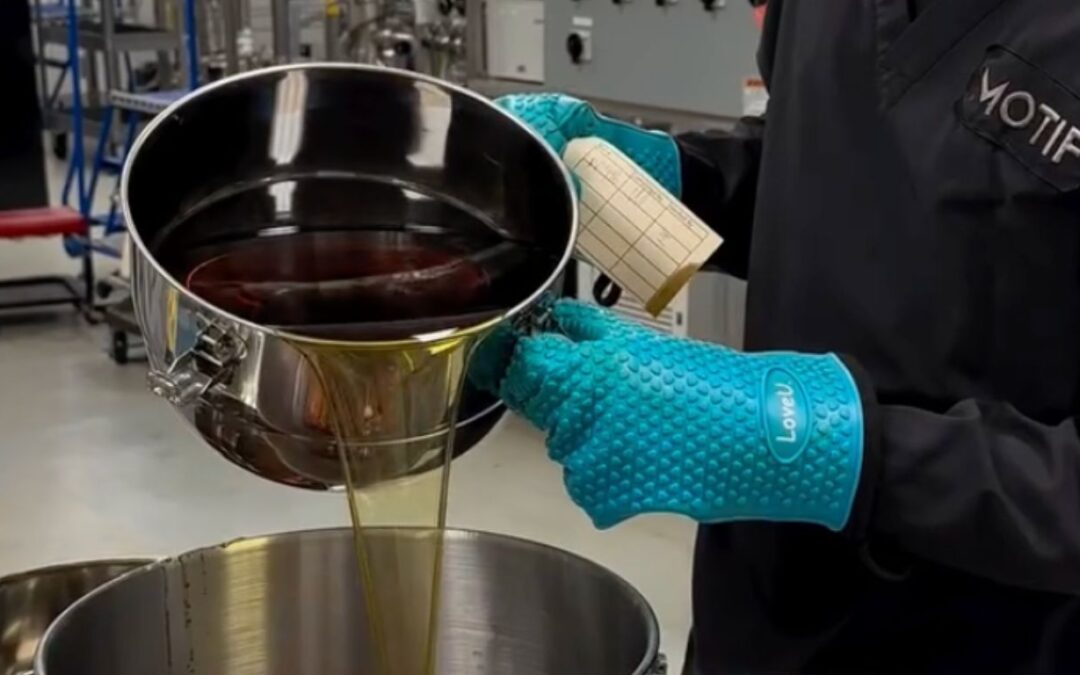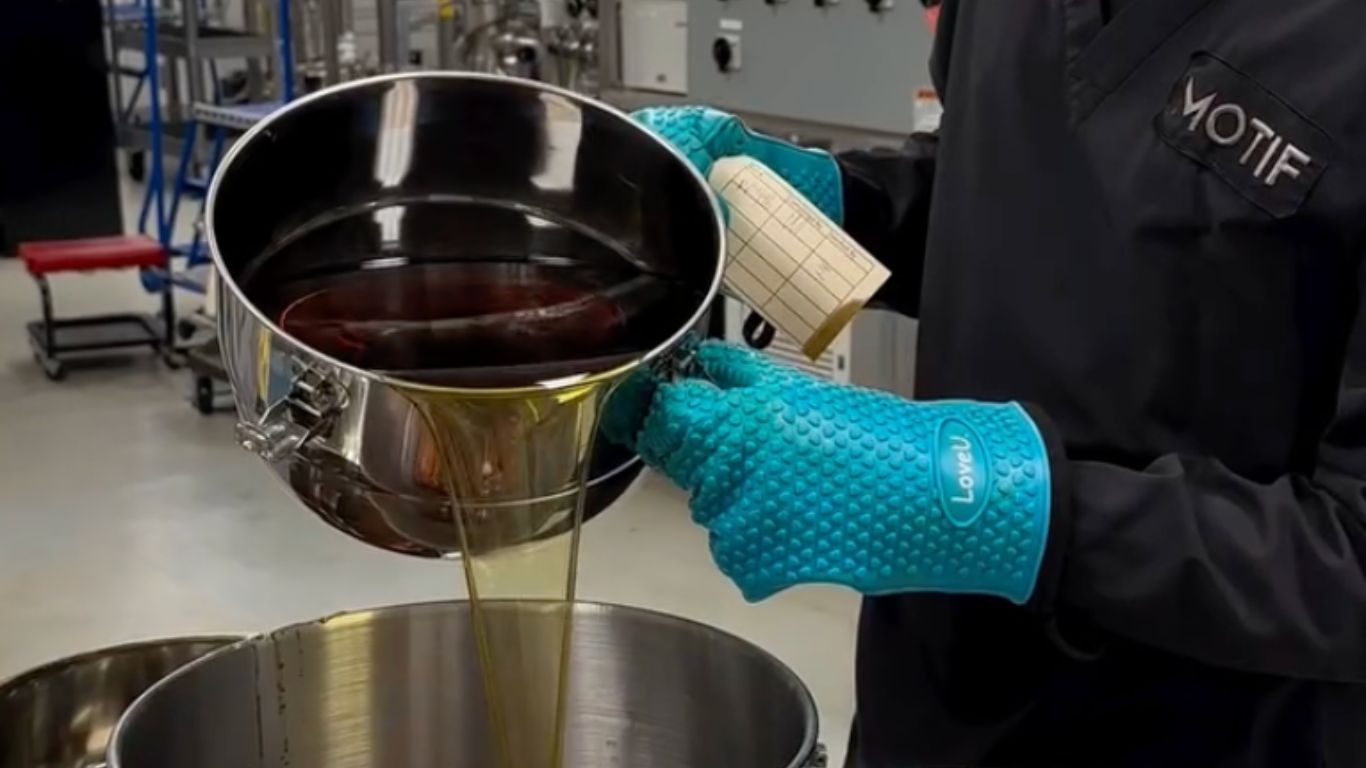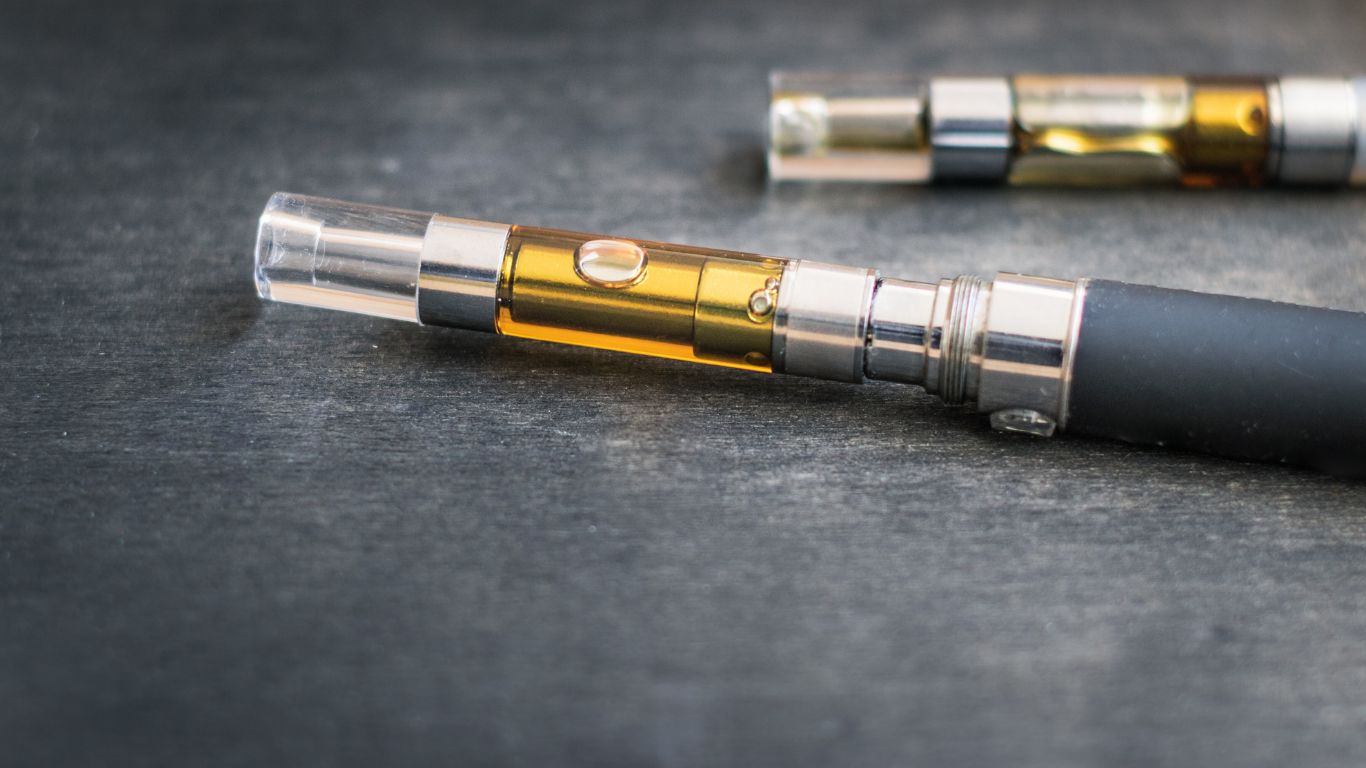
by Grow Up Conference | Dec 6, 2024 | Media Partners, Stratcann
Organigram Holdings Inc. has acquired cannabis extractor Motif Labs Ltd. for $90 million in a stock and cash deal.
The move, consisting of $50 million in cash and $40 million of Organigram common shares, says the company, makes Organigram the largest cannabis company with a combined market share of 12.4%. Motif holds 21.2% and 9.4% share of the Canadian vape and infused pre-roll markets, respectively, according to data from Hifyre.
This will mean the combined companies will have a combined market share of 21.7% for vapes, 9.6% for pre-rolls, including 16% for infused pre-rolls, 14.1% for concentrates, 21.6% in the hash category, 11.2% in cannabis flower and 47% in milled flower, and a 19.2% market share of cannabis gummies.
“This deal is about a leading public cannabis company joining forces with Canada’s top private licensed producer,” said Paolo De Luca, Chief Strategy Officer at Organigram in a press release. “We are extremely excited about leveraging our combined competitive advantages and respective market positions to continue to grow in Canada and beyond.”
Located in Aylmer, Ontario, Motif is a Canadian leader in the vape and infused pre-roll categories with a portfolio of brands like BOXHOT and Debunk, Boondocks, and Rizlers, and wholesale sales and services for external brands. The company grew from $35 million in net revenue in 2022 to $79 million in 2023 and has generated approximately $86 million in the past year. Motif also has a storage facility in London, Ontario, which Organigram plans to use as a distribution hub.
The Aylmer facility provides Organigram with monthly production of 1,350 kgs of distillate, 400 kgs of high-value hydrocarbon extracts, 750k infused pre-rolls capacity, and 1 million units of vape filling capacity.
The cannabis extractor can produce 1,350 kg of distillate per month and 400 kg of hydrocarbon-derived extracts. The company can also produce THCA, an increasingly popular cannabinoid among consumers.
Said Beena Goldenberg, CEO of Organigram: “The highly complementary acquisition of Motif establishes Organigram as Canada’s largest cannabis company by market share and accelerates our vision to be a leading cannabis company across all major categories, driven by a relentless focus on the consumer of today and tomorrow.”
Mario Naric, CEO and Founder of Motif, said: “This is a landmark transaction in our industry and the Motif team is thrilled to be joining forces with Organigram to create Canada’s undisputed leader with deep capabilities in all major cannabis categories.”
Organigram reported net revenue of $41.1 million for the third quarter of 2024 and net income of $2.8 million, compared to a loss of $213.5 million in the same reporting period in 2023.
The majority of the company’s net revenue for the three months ended June 30, 2024, came from sales in Canada’s non-medical “adult use” market ($36.5 million or 89%), while just 6% of sales ( $8.3 million) were to the international markets and 1% of sales ($325,000) were into Canada’s medical cannabis market.
Sale of cannabis flower was 58% of Organigram’s business in Q3 2024, at an average cost of $1.50 per gram, down from $1.67 per gram in the same quarter in 2023 and $1.51 from Q2 2024.
In May 2024, Organigram announced a three-year supply agreement with Avida Medical in the UK, with the potential to supply 1,700 kilograms of indoor-grown dried cannabis flower to Avida. In June, it announced a plan to acquire a minority stake in Berlin-based cannabis company Sanity Group, expanding Organigram’s footprint in Europe.
In August, Organigram announced new nanoemulsion technology in collaboration with British American Tobacco. Organigram was one of three Canadian cannabis companies named in a report from the Israeli government that proposes levies on Canadian cannabis products entering the country.
In September, Organigram closed on its second round of funding from British American Tobacco.
This is the second of three rounds of funding from BT DE Investments Inc., a wholly-owned subsidiary of BAT. Plans for the partnership between British American Tobacco and Organigram were announced in late 2023, with an investment of nearly $125 million from BAT.
At the time, Organigram said most of the $124.6 million investment would be used to create a strategic investment pool named Jupiter, focusing on emerging cannabis opportunities, including geographic expansion.
The first round of funding closed on January 23, 2024. The third round of funding is expected in early 2025.
Motif was the largest privately owned cannabis business in Canada prior to the completion of the transaction.
Related Articles

by Grow Up Conference | Dec 6, 2024 | Cannabis News Wire, Media Partners
Marijuana farmers in the state of California revealed that the weather during this year’s growing season was favorable, which may improve yields and in turn, prices.
Judi Nelson, co-founder of Sol Spirit Farm, revealed that the summer was good for them, noting that moisture from spring rain prevented wildfires. The overall threat of wildfires was low this year for cannabis farmers, which allowed them to focus on their crops more. In the last couple of years, these fires have greatly impacted farmers, with some experiencing extensive crop loss.
Flower from Sol Spirit is primarily sold in the firm’s compostable packaging, which Nelson reveals tells their story. The farm’s plants are certified regenerative, which permits the firm to price its flower higher than other brands.
There are tiers to sun-grown cannabis products; top shelf, mids and mass-produced. Most of the products that come from California’s Emerald Triangle are top shelf.
Sol Spirit flower is priced almost 3.5 times more than mass-produced flower because of the time the firm puts into its product as well as product quality. Marijuana cultivated in the sun is said to have an earthy aromas and rich terpene profiles, which enthusiasts note are more natural in comparison to strains cultivated indoors.
Nelson believes that prices for craft flower will increase especially as some players exit the market, noting that consumers want high quality flower that’s not been exposed to any impurities.
Nya Hessler of Amaranth Farms expects that despite an abundance of craft marijuana flower in the market, product will be going for roughly $500 per pound. While this is good, taxes for sun grown marijuana remain high.
Ironside Gardens owner Peter Maric has proposed that excise tax for all sun grown products be reduced to 5-7%. This comes after an announcement was made that marijuana excise taxes would increase to 19% from 15% in 2025.
Following the pesticide scandal that occurred earlier in the year, demand for sun-grown marijuana is also expected to increase. To prevent lower demand from consumers, some brands have eliminated the use of organic pesticides in their operations. Autumn Brands, based in Carpinteria, is one of these brands. The firm has fully transitioned to an all-natural marijuana pest management system that uses ladybugs native to the state.
This comes after it also threw away thousands upon thousands of cannabis plants that had been sprayed with organic pesticides after research demonstrated that these chemicals were harmful when heated.
Industry actors and allied players like Innovative Industrial Properties Inc. (NYSE: IIPR) are glad that there is some good news coming out regarding the cannabis industry in California since several challenges, such as high taxes, have been weighing down licensed players in that jurisdiction.
About CannabisNewsWire
CannabisNewsWire (“CNW”) is a specialized communications platform with a focus on cannabis news and the cannabis sector. It is one of 70+ brands within the Dynamic Brand Portfolio @ IBN that delivers: (1) access to a vast network of wire solutions via InvestorWire to efficiently and effectively reach a myriad of target markets, demographics and diverse industries; (2) article and editorial syndication to 5,000+ outlets; (3) enhanced press release enhancement to ensure maximum impact; (4) social media distribution via IBN to millions of social media followers; and (5) a full array of tailored corporate communications solutions. With broad reach and a seasoned team of contributing journalists and writers, CNW is uniquely positioned to best serve private and public companies that want to reach a wide audience of investors, influencers, consumers, journalists and the general public. By cutting through the overload of information in today’s market, CNW brings its clients unparalleled recognition and brand awareness. CNW is where breaking news, insightful content and actionable information converge.
To receive SMS alerts from CNW, text CANNABIS to 888-902-4192 (U.S. Mobile Phones Only)
For more information, please visit https://www.CannabisNewsWire.com
Please see full terms of use and disclaimers on the CannabisNewsWire website applicable to all content provided by CNW, wherever published or re-published: https://www.CannabisNewsWire.com/Disclaimer
CannabisNewsWire
Denver, CO
www.CannabisNewsWire.com
303.498.7722 Office
Editor@CannabisNewsWire.com
CannabisNewsWire is powered by IBN

by Grow Up Conference | Dec 5, 2024 | Cannabis News Wire, Media Partners
Mississippi’s medical cannabis businesses are prohibited from advertising on billboards or any other platforms due to marijuana’s federal status as an illegal substance, according to a recent decision by an appeals court.
The owner of Tru Source Medical Marijuana, a medical cannabis store operating in Olive Branch, Mississippi, contested this restriction. He claimed that since state law allows the sale of marijuana, the First Amendment should protect medical cannabis businesses’ advertising rights.
However, on Friday, a three-judge bench from the 5th Circuit Court of Appeals ruled against the dispensary owner. The court referred to the federal Controlled Substances Act (CSA), which has classified marijuana as an illegal drug since 1970, banning its production, distribution, and possession. The ruling emphasized that federal law takes precedence and that Mississippi’s restrictions on advertising are consistent with this overarching legal framework.
“Mississippi is not subject to constitutional barriers in limiting commercial speech that pertains to unlawful activities,” the judges stated in their decision.
The state attorney general welcomed the ruling, describing the state’s advertising restrictions as reasonable. MaryAsa Lee, a spokesperson for the office, highlighted that the decision reinforces the state’s efforts to regulate medical cannabis advertising through various media, including broadcast, digital platforms, and print.
Tru Source CEO and founder, Clarence Cocroft II, filed a lawsuit in 2023 to contest the ban on advertising through text messages, mass emails, social media, broadcast, billboards, or print.
Cocroft expressed frustration over the decision, noting that the restrictions make it challenging to reach potential clients and educate the public about the state’s medical cannabis program. Despite the setback, Cocroft stated that he remains determined to continue advocating for equitable treatment of medical cannabis businesses.
Although direct advertising is heavily restricted, the state does allow businesses to maintain social media profiles and websites that provide information about their locations and product offerings. Additionally, businesses can list their information in business directories and phone books and include marijuana imagery in their logos. They are also permitted to sponsor advocacy or charitable events.
Cocroft’s legal representation, the Institute for Justice, a not-for-profit law firm, is exploring further legal options. The firm is considering asking the appeals court to review the case or potentially escalating the matter to the apex court. Ari Bargil, an attorney from the firm, criticized the contradictory stance of the state, arguing that it’s unreasonable to create a legal market for medical cannabis while relying on federal law to restrict communication between businesses and consumers.
Established marijuana firms like Canopy Growth Corp. (NASDAQ: CGC) (TSX: WEED) operating in other jurisdictions understand the frustrations that come with marijuana advertising restrictions in a highly competitive environment. The industry hopes that firms in Mississippi find creative ways to reach their potential clients without breaking any existing laws.
About CNW420
CNW420 spotlights the latest developments in the rapidly evolving cannabis industry through the release of an article each business day at 4:20 p.m. Eastern – a tribute to the time synonymous with cannabis culture. The concise, informative content serves as a gateway for investors interested in the legalized cannabis sector and provides updates on how regulatory developments may impact financial markets. If marijuana and the burgeoning industry surrounding it are on your radar, CNW420 is for you! Check back daily to stay up-to-date on the latest milestones in the fast -changing world of cannabis.
To receive SMS alerts from CNW, text CANNABIS to 888-902-4192 (U.S. Mobile Phones Only)
For more information, please visit https://www.CannabisNewsWire.com
Please see full terms of use and disclaimers on the CannabisNewsWire website applicable to all content provided by CNW, wherever published or re-published: https://www.CannabisNewsWire.com/Disclaimer
CannabisNewsWire
Denver, CO
www.CannabisNewsWire.com
303.498.7722 Office
Editor@CannabisNewsWire.com
CannabisNewsWire is powered by IBN

by Grow Up Conference | Dec 5, 2024 | Grow Opportunity, Media Partners
(Globe Newswire) Toronto – Avicanna Inc. a commercial stage, international biopharmaceutical company focused on the commercialization of cannabinoid-based products, is pleased to announce the initial delivery of its proprietary topical products into Europe as a part of the previously announced exclusive supply agreement with a multinational pharmaceutical company.
“We are pleased to compete first delivery of our products and are excited about the potential of these innovative products in the German and European over the counter markets. These formulations were developed though our Canadian R&D platform and manufactured through South American operations with our source of cannabinoids including, CBD and CBG. This combination acts as a validation of our long-term business model and international expansion plans for our proprietary and evidence-based products,” stated Aras Azadian, CEO at Avicanna Inc.
The products include 3% CBD localized cream and the 2% CBD and 0.5% CBG transdermal gel utilizing the Company’s patented deep tissue technology. The 3% CBD localized cream, as well as the 2% CBD and 0.5% CBG transdermal gel products completed human irritation and real-world evidence studies.
The multinational pharmaceutical company manufactures and markets a wide range of pharmaceutical products across 4 continents and has established commercial infrastructure in the European region that will be utilized for the initial launch of the selected products. [They have] committed to launch the initial products in 6 European countries during 2025 with expectations of further expanding throughout the European region shortly after.
Avicanna has earned licensing fees for meeting specific milestones this year. Additionally, the parties agreed to specific minimum order quantities and commercial milestones for the multinational pharmaceutical company to maintain the exclusivity.
The products were manufactured using the Avicanna’s Colombian operations while utilizing Avicanna’s own source of Aureus branded organic and sustainable cannabinoids including CBD and CBG from its majority owned subsidiary, Santa Marta Golden Hemp S.A.S.
Avicanna carries out its operations in compliance with all applicable laws in the jurisdictions in which it operates.
About Avicanna:
Avicanna is a commercial-stage international biopharmaceutical company focused on the advancement and commercialization of cannabinoid-based products and formulations for the global medical and pharmaceutical market segments. Avicanna has an established scientific platform including R&D and clinical development leading to the commercialization of more than thirty proprietary, evidence-based finished products and supporting four commercial stage business pillars.

by Grow Up Conference | Dec 5, 2024 | Media Partners, The New Agora
10 Signs You May Be a Meta Male
By Gary. Z. McGee
“Only a few know, how much one must know to know how little one knows.” ~Werner Heisenberg
The concept of “Meta male” isn’t a term with a widely accepted or standardized definition in social or psychological literature, but if we were to extrapolate from the terms “Alpha” and “Beta” and apply the prefix “Meta-” (which often implies something beyond, over, or transcending), we could infer some characteristics. Here’s a speculative take on what a Meta male might embody, contrasting with the more traditional Alpha and Beta male archetypes.
1.) Transcendence:
“Elevate yourself above the battlefield.” ~Robert Greene
As a meta male you move beyond traditional power dynamics. You’re not focused on being at the top or in support roles but on being where you can most effectively contribute or innovate. Which is above the battlefield playing the Infinite Game of life despite the petty finite games of Alphas and Betas.
Understanding that everything is connected to everything else, you cultivate ruthless nonattachment. Perched up high, seeing with “Over Eyes,” counterbalancing with Middle Way Dynamics, you personify wholeness through otherworldliness.
2.) Adaptability:
“All fixed set patterns are incapable of adaptability or pliability. The truth is outside of all fixed patterns.” ~Bruce Lee
You are highly adaptable to various social, professional, or personal environments without losing identity or purpose. You are a Nietzschean self-overcomer par excellence. Flexible and open, you are adept at adapting to the vicissitudes of change.
Understanding that a mind set in its ways cannot respond effectively to new challenges or information, you encourage openness to new ideas, flexibility in thought and action, and a readiness to unlearn or alter your approach when necessary. It’s a call to avoid dogmatism and embrace a more fluid, responsive way of living and thinking.
3.) Integrative:
“Wholeness is not achieved by cutting off a portion of one’s being, but by integration of the contraries.” ~Jung
You balance traits typically associated with Alpha and Beta males. You can lead when necessary but also support and collaborate equally well.
You understand the vital importance of shadow work. Where most Betas would avoid the shadow and most Alphas would fight against it, you integrate it. You initiate the monster. You baptize the beast. You assimilate the demon. You honor your inner darkness by shining its uncomfortable blacklight into the blinding light of the all-too-comfortable world.
4.) Self-awareness:
“I want to keep smashing myself until I am whole.” ~Elias Canetti
You have a deep understanding of yourself, including strengths, weaknesses, desires, and fears, which allows for personal growth beyond societal expectations. You are hyperaware that the Self is masks all the way down perceiving delusions all the way up. Such higher awareness gives you the ability to question yourself to the nth degree.
This leads to the ability to overcome yourself. Self-overcoming becomes a chisel for the hardened beliefs within you. You use it to humble yourself, to destroy your delusions, to unsettle your settled mind, to shock your chakras, and to recondition your cultural conditioning.
5.) Emotional maturity:
“The emotionally intelligent person knows that love is a skill, not a feeling, and will require trust, vulnerability, generosity, humor, sexual understanding, and selective resignation.” ~Alain de Botton
You manage emotions effectively by not suppressing them like an Alpha or being overly influenced by them like a Beta. Instead, you transform them into high art through emotional alchemy.
You transform the emotion of fear into courageous action for example. This can be applied to almost any emotion. You Feel grief but act with steadfastness. You feel envy but act with emulation. You feel triggered but act with curiosity. You feel vengeful but act with forgiveness.
6.) Innovative:
“Great men are like eagles and build their nest on some lofty solitude.” ~Arthur Schopenhauer
You look for new ways to solve problems. Often outside of traditional paths.
You are a pathfinder. You have the courage to do the taboo thing, the audacious thing, the insouciant thing, the eccentric thing, the unpopular thing, realizing that without your unique spark, no outside the box thought, no otherworldly imagination, no arguments with God, no crucifixion of the past could be possible.
You wield Innovation like a question mark sword, realizing that asking difficult questions will always be more important than receiving simple answers.
7.) Big-picture leadership:
“As anywhere else in the world, the unwritten law defeated the written one.” ~Herman Hesse
Your leadership style is transcendent. It’s elevated. You see the big picture. You see how the unwritten law will always overrule the written law, and you lead by this example.
You realize that true leaders do not go where the path may lead; they go where there is no path and leave a trail. The unique function of your style of leadership is the elevation of perspective and the cultivation of the third eye. Being confident in this regard, you stand out from the crowd and fulfill your role as visionary.
You become an icon of iconoclasm, a force of nature that leads by example whether or not anybody else decides to “follow.”
8.) Resilience:
“Let me fall if I must fall. The one I am becoming will catch me.” ~Baal Shem Tov
You don’t just endure challenges, you grow from them, learning and adapting along the way. You transform demons into diamonds, wounds into wisdom, and setbacks into steppingstones.
You are antifragile. You understand that pressure is needed to forge the diamond. Not comfort, not security, not safety, but pressure. So it goes also for the rough diamond of the soul. Pressure is needed to smooth out the edges; to make it more resilient, more robust, more antifragile.
9.) Relational:
“The only way of loving a person is to love them without hope.” ~Walter Benjamin
You value deep, meaningful connections over shallow, transactional relationships, understanding that genuine connection is a two-way street and love is never a product to be owned but an energy to be shared.
You love without expectation, without hope, without an agenda. You allow others to love the way they must love. You let go of your ego’s attachment to love. You practice agape-love, cosmic, transcendent, and nonattached. You love at the edge of the human condition: fallible, uncertain, hungry, and in a frenzy.
10.) Holistic success:
“Now I am nimble, now I fly, now I see myself under myself, now a god dances within me.” ~Nietzsche
Your success isn’t just financial or hierarchical but includes mental health, personal fulfillment, spirituality, and contributions to society or community through high art.
Beyond codependence and independence, there is the holistic state of interdependence. This is where you reside. Your next-door neighbor is the mighty Phoenix. Together, you practice the art of the life-death-rebirth process.
Through your absolute nonattachment, you see how everything is attached to everything else. The entire story of the human leitmotif unfolds below you, glimmering with the promise of hidden gems, diamonds in the rough, gold in the mud—all just waiting to be plucked by someone nonattached enough to seize it, utilize it, and transform it into a magic elixir for the “tribe.”
Image source: The Walker on a Sea of Stars by Julian Majin
About the Author:
Gary Z McGee, a former Navy Intelligence Specialist turned philosopher, is the author of Birthday Suit of God and The Looking Glass Man. His works are inspired by the great philosophers of the ages and his wide-awake view of the modern world.
This article (10 Signs You May Be a Meta Male) was originally created and published by Self-inflicted Philosophy and is printed here under a Creative Commons license with attribution to Gary Z McGee and self-inflictedphilosophy.com. It may be re-posted freely with proper attribution, author bio, and this statement of copyright.



by Grow Up Conference | Dec 5, 2024 | Garden Culture Magazine, Media Partners
Living in the mountains of Quebec, Canada, has its perks. Mostly tucked away from the urban sprawl, we are surrounded by natural beauty and truly experience all four seasons. The summers are busy with locals and tourists enjoying outdoor activities, cultural events, and an abundance of farmers’ markets. Eating locally grown food is easy in the summer and fall. But after the colorful leaves fade in October, the outdoor markets pack it in for another season, and the snow flies. If you’re on skis or snowshoes in Quebec, there is no shortage of tracks to follow through the woods. But the abundance of fresh, local food hits a dead end. That’s life in colder climates; most farmers cram their growing into six months, and in the winter, they rest.
Is It Possible to Grow Vegetables During Winter?
It doesn’t have to be this way; small-scale, regenerative farmers Jean-Martin Fortier and Catherine Sylvestre are leading the change. Fortier co-founded the research farm, la Ferme des Quatre-Temps (The Four-Season Farm) in Hemmingford, QC; Sylvestre, a professional agronomist, is the farm manager and trains future farmers. They have co-authored The Winter Market Gardener: A Successful Grower’s Handbook for Year-Round Harvests to help improve the agricultural landscape with more all-season gardens.
“Our goal is to show how we can eat locally year-round,” explains Sylvestre. “We want to develop techniques that allow people in northern climates always to buy food in their community and never have to import any vegetables.”


Sounds dreamy, doesn’t it? It also seems impossible for anyone looking at a winter storm rage outside their windows. But growing vegetables and harvesting them throughout the cold seasons is doable. Sylvestre and Fortier have spent years testing various crops and growing methods on their farm; they know it works. They successfully grow over 30 vegetables at la Ferme des Quatre-Temps in the winter! While the book’s target audience includes small-scale farmers and market gardeners living in cooler climates, home growers can apply the same ideas and principles in their garden beds. The book even offers a small-scale home garden plan for the fall.
“What we wanted was to [share that knowledge] so that farmers can start at the point where we are and not have to do all of these trials and repeat the mistakes we made because they can be quite costly,” says Sylvestre.
Is Winter Gardening Costly?
Many people in cold regions assume winter growing has a hefty price tag. However, The Winter Market Gardener offers economical solutions that don’t involve state-of-the-art greenhouses and expensive electricity bills. Instead, Fortier and Sylvestre discuss using simple shelters to protect crops from the cold. These can be used individually or in frigid temperatures, combined and layered like an onion. From caterpillar and low tunnels to permanent high tunnels and row covers, the handbook explores each option, offers advice on creating and maintaining the perfect environment, and provides results on how each performs compared to a heated greenhouse.
Using the right structures makes winter growing possible and affordable, and Sylvestre adds that crop selection is also critical to success. Did you know you can increase a plant’s cold hardiness? That’s another riveting topic Fortin and Sylvestre explore in their book.
“We always want to grow food that is in season,” she says. “So what we grow in the winter are vegetables that like the cold. We won’t be heating greenhouses at 20-25°C to grow tomatoes; it doesn’t make sense, is expensive, and takes a lot of energy.”


Winter Crop Selection: Vegetables That Grow During Winter
The winter garden should include two crop categories. Carrots, parsnips, potatoes, and rutabagas are root vegetables; planting them in August is optimal for harvest in the fall. When everything is covered with white in the winter, Sylvestre suggests going green. Swiss chard, kale, arugula, mesclun, and Asian greens are well-suited to colder temperatures and produce yields with a low energy supply, busting the myth that heat is the deciding factor in winter growing.
“I’m focusing on Asian vegetables because they will grow even when there isn’t a lot of light,” she says. “This makes all the difference because our biggest limiting factor in the winter is not having a lot of light.”
A greenhouse is necessary to grow and harvest throughout the winter. A tempo or car shelter will also do the trick. They don’t have to be heated; Sylvestre recommends planting your greens in September and adding row covers inside the structure of your choice for added heat. What’s paramount is that the covers be transparent so that as much light as possible gets through, ensuring that the crops can survive when temperatures dip to the minus 20s.
“People need to see with their own eyes that it’s possible,” she says. “When you [enter] the unheated greenhouse in the morning, it’s crazy; all vegetables are frozen. But when the sunlight [returns], everything thaws, and the vegetables look luxurious again. It’s like magic.”
Changing Tides
Sylvestre recommends growing spinach if you’ve never tried gardening in the winter. It’s exceptionally cold-hardy and easy to grow. But be warned that growing a successful crop in the cold is addictive. Sylvestre says she’s met many small-scale farmers who have read her book and started experimenting with cold-season crops. They’re waking from their winter slumber, and some are flipping the script and slowing down in the summer to focus more on growing in the cold.
“In the summer, they’ll grow all their storage crops, and in the winter, they will grow their leafy greens,” she explains. “They don’t have to compete with all of the other farmers in the summer, and they can focus on the winter season where there is almost no competition.”
The Winter Market Gardener says farmers can be profitable by following the models at la Ferme des Quatre-Temps. They will succeed with the right timing, spacing, crops, and covers. Sylvestre encourages them to consider packing their fresh greens into weekly CSA boxes or selling their harvests to restaurants striving to make their menus more appealing with local food. A word of advice? Allow yourself to move slowly in the winter; don’t try to keep up with the summertime rush because it’s impossible.
“Everything in the winter is so slow,” explains Sylvestre. “The plant growth is super slow. You can take your time [and] don’t have to rush anything (…) It’s nice to have two different paces. [In the winter] when there’s no sun, we go home. It’s different from the summer, which is always go, go, go.”


Making it Simple
Growing food throughout the winter can seem overwhelming, but The Winter Market Gardener is excellent for anyone interested in boosting local food security. Fortin and Sylvestre have been careful not to be overly scientific or complicated, breaking years of research, successes, and failures into an easy-to-follow and enjoyable read. It wasn’t easy, but Sylvestre knows it was worth it.
“We like difficult things,” she laughs. “We were motivated by that.”
She’s witnessing a revolution in cold-climate vegetable production and says the future is bright for Quebec farming. She’s noticing more small market gardens run by young people popping up throughout the province and believes that farms have the potential to become community hubs once again. So, give it a try; read The Winter Market Gardener and marvel at the magic of growing greens in the cold. And if you find local farmers near you that grow throughout the winter, please support them. They’re the future of agriculture.
For more information on the incredible work at la Ferme des Quatre-Temps, check out fermequatretemps.com. Order a copy of The Winter Market Gardener: A Successful Grower’s Handbook for Year-Round Harvests here.

by Grow Up Conference | Dec 5, 2024 | Media Partners, Stratcann
New legislation in PEI is clarifying that the province’s 2021 ban on the sale of flavoured vaping products does not apply to the sale of cannabis vapes.
However, a representative for PEI Cannabis tells StratCann that there has been no change in policy in regard to what products PEI Cannabis Management Corporation (PEICMC) can sell. A request for clarification of whether any relevant changes could be coming in the future in the wake of this new legislation was not provided.
Bill 71, An Act to Amend the Tobacco and Electronic Smoking Device Sales and Access Act, was introduced in PEI’s legislature on November 7, 2024. The legislation includes two amendments that clarify the 2021 amendments to the province’s Tobacco and Electronic Smoking Device Sales and Access Act and regulations. Bill 71 passed and received Royal Assent on Friday, November 29, 2024, although it has yet to come into force.
Those amendments point out that the 2021 amendments do not affect the authority of the province’s Cannabis Management Corporation under the Cannabis Management Corporation Act to sell, offer to sell, expose for sale and have in its possession for sale, to persons who may lawfully purchase cannabis items that are related to or used in the consumption of cannabis.
This includes the ability to sell various cannabis products, clarified Nichola Hewitt, solicitor and legislative specialist with the Department of Health and Wellness, during discussions about the bill on November 8. In response to a question from Matthew B. MacFarlane, Green MLA for Borden-Kinkora, about the sale of cannabis distillate vape cartridges, Hewitt said the new amendments address this.
“The Cannabis Management Corporation Act sets out what Cannabis PEI can sell, the products. Right now, as a result of the private member bill that came out several years ago, there was some confusion, and this is clarifying it,” she explained. “Papers are an example.
“Papers are deemed to be part of the tobacco-related products, so Cannabis PEI is saying, ‘Well, you’re governing the papers, so we can’t really sell that or the distillate.
“So, the amendment makes it absolutely clear: something that falls under the authority of the Cannabis Management Corporation Act, this act doesn’t apply to that.”
PEI-based cannabis brand, FIGR, which sells cannabis vapes that are available for purchase in other parts of the country, was briefly mentioned during discussion of the bill by Mathew M. MacFarlane, Green Party MLA for the riding of Borden-Kinkora. MacFarlane noted that FIGR, the brand connected to cannabis producer Canada’s Island Garden, cannot sell its vapes in its home province through PEI Cannabis.
PEI sold nearly $25 million worth of cannabis in 2023-2024.
Cannabis vape pens have been increasingly gaining market share in the legal market. Although dried flower has maintained the its top spot, its overall market share has been declining as inhaled extracts, especially vapes, have been steadily increasing. Sales of dried cannabis declined from 71% market share in 2021-2022 to 64.9% in 2022-2023.
Based on the most recent annual figures from Statistics Canada, the largest contributor to the increase in overall cannabis sales across Canada was inhaled extracts, which rose by 59% in the 2022 to 2023 fiscal year. This category accounted for 67.6% of the $600 million increase in sales from the previous year, or more than $405 million.
In 2022, Newfoundland and Labrador began allowing the sale of cannabis vapes.
The SQDC recently announced it would begin selling cannabis vape products by the fall of 2025, which would make PEI the only province left that does not allow the sale of cannabis vape pens. Despite the ban, one quarter of cannabis-using Quebecers report using cannabis vapes, according to figures from the Institut de la statistique du Québec (ISQ).
A recent report out of New Brunswick showed high levels of pesticides in illegal cannabis vapes, which are often easily found online or in unlicensed stores.
Related Articles

by Grow Up Conference | Dec 5, 2024 | Cannabis News Wire, Media Partners
In 2022, the Biden Administration initiated efforts to reevaluate how cannabis is classified under federal law, leading the DEA to start a formal rule-making procedure this year.
If the agency ultimately agrees with the Health and Human Services (HHS) Department’s recommendation for reclassification, the effects at the state level are likely to be minimal. Without broader federal changes, state programs for medical and recreational marijuana will remain at odds with federal law. Current regulations provide states with little leeway to legalize substances classified under Schedule III.
Consequently, the agency is unlikely to issue licenses to state-regulated cannabis businesses, and the FDA is not expected to approve botanical marijuana as a prescription drug. This means the legal status of the state marijuana market will likely remain as uncertain as it is today.
However, the situation in Washington, D.C., is distinct. Reclassifying marijuana could significantly impact the local cannabis market in the country’s capital. This is due to a budget provision—the Harris rider—introduced in 2014 by Maryland Republican Representative Andy Harris.
The amendment, attached to D.C.’s annual appropriations bill, aimed to limit the District’s ability to implement broader marijuana policies. It was introduced after the D.C. Council decriminalized marijuana possession and voters passed Initiative 71, which legalized cannabis use, possession, and limited home cultivation.
When the Harris rider was enacted, D.C.’s non-voting Congressional delegate, Eleanor Holmes Norton, pointed out that the provision restricted the use of funds to “enact” but not to “carry out or enact” cannabis policies. This allowed the state Attorney General to affirm that the measure could proceed as self-enacting legislation, enabling certain cannabis-related activities without the need for additional government action.
Since the measure didn’t legalize marijuana sales or establish a framework for regulatory oversight, D.C. has been unable to regulate recreational cannabis sales, as doing so would require new legislation prohibited by the Harris rider.
This legal limitation has contributed to the growth of a gray market in D.C., where businesses comply with Initiative 71 by “gifting” marijuana with the purchase of other items. These operations lack the consumer protections seen in other states with regulated cannabis markets. To address this issue, the D.C. Council has focused on expanding its medical cannabis program as it cannot directly regulate recreational sales under the current law.
Rescheduling cannabis could present an opportunity for D.C. to achieve comprehensive cannabis regulation. The Harris rider specifically prohibits the use of funds to regulate substances classified as Schedule 1 or certain tetrahydrocannabinols. If marijuana is moved to Schedule III, this restriction may no longer apply.
Even if the Council moves forward with legislation to regulate recreational cannabis, opposition from some members of Congress is expected. However, unless Congress takes direct action to block such measures, rescheduling could give D.C. the authority to establish a regulated cannabis market and regain control of its marijuana policy.
The entire marijuana industry, including entities like Cronos Group Inc. (NASDAQ: CRON) (TSX: CRON), awaits the final rule-making decision that the DEA will announce. That decision could reshape the trajectory of the marijuana industry in the U.S.
About CannabisNewsWire
CannabisNewsWire (“CNW”) is a specialized communications platform with a focus on cannabis news and the cannabis sector. It is one of 70+ brands within the Dynamic Brand Portfolio @ IBN that delivers: (1) access to a vast network of wire solutions via InvestorWire to efficiently and effectively reach a myriad of target markets, demographics and diverse industries; (2) article and editorial syndication to 5,000+ outlets; (3) enhanced press release enhancement to ensure maximum impact; (4) social media distribution via IBN to millions of social media followers; and (5) a full array of tailored corporate communications solutions. With broad reach and a seasoned team of contributing journalists and writers, CNW is uniquely positioned to best serve private and public companies that want to reach a wide audience of investors, influencers, consumers, journalists and the general public. By cutting through the overload of information in today’s market, CNW brings its clients unparalleled recognition and brand awareness. CNW is where breaking news, insightful content and actionable information converge.
To receive SMS alerts from CNW, text CANNABIS to 888-902-4192 (U.S. Mobile Phones Only)
For more information, please visit https://www.CannabisNewsWire.com
Please see full terms of use and disclaimers on the CannabisNewsWire website applicable to all content provided by CNW, wherever published or re-published: https://www.CannabisNewsWire.com/Disclaimer
CannabisNewsWire
Denver, CO
www.CannabisNewsWire.com
303.498.7722 Office
Editor@CannabisNewsWire.com
CannabisNewsWire is powered by IBN

by Grow Up Conference | Dec 4, 2024 | Media Partners, Stratcann
The Ontario Cannabis Store (OCS) is promoting its ongoing Cannabis Made Clear campaign over the holiday season, sharing tips and resources for safe and responsible cannabis consumption.
First launched in 2022, the Cannabis Made Clear campaign is part of the provincial cannabis agency’s mandate to promote responsible cannabis consumption and includes marketing campaigns across the province targeting consumers, non-consumers, residents and visitors alike.
As people gather and enjoy holiday festivities over the coming winter months, the OCS’s senior manager of social responsibility, Dr. Jenna Valleriani, PhD, shares tips for safer consumption and discusses some of the issues the campaign focuses on this season.
“The first age old harm reduction tip is always to start low and go slow,” says Valleriani. “And what that really means is to consume a little bit and wait a bit of time to feel the effects before you consume more.”
She says this is especially true with edibles, which could be a gift over the holidays, possibly even a gift to someone without much experience with cannabis.
“My suggestion is to always start with 2 or 2.5 milligrams if you’re unsure what that will feel like and always wait a full hour before consuming more, just so you can enjoy the experience and make sure that you’re not over-consuming.”
Another issue, not only with edibles but with other types of cannabis products, including leftover joints and roaches, is to ensure safe storage and disposal, Valleriani adds. Not only do you want to ensure kids don’t accidentally ingest cannabis gummies or chocolates they might mistake as regular candy at a family gathering, but pets have been reported to at times ingest joints left on the ground, leading to a potentially bad Christmas for Fido.
Other issues Valleriani highlights are being safe on the roads and ensuring you have arranged transportation if you are planning on consuming any cannabis products of any kind. This is especially true for young people, she points out, who have a zero tolerance for any cannabis in their system.
Instead, she recommends planning ahead and using ride-sharing, taxis, public transportation, or the help of friends or family.
People will also want to be aware that consuming cannabis with alcohol can greatly enhance the effects of both of these intoxicants, even for a seasoned consumer of either.
Lastly, she discusses that if edibles are a part of a social gathering and available for consumption, take the time to clearly label which products are infused and which aren’t, and ideally, keep them separate from each other to avoid accidental consumption.
The holiday Cannabis Made Clear campaign runs from December 2 to January 26. It includes ads on billboards around Ontario, across different campus networks, Rogers Sportsnet, and various online platforms like Snapchat.

by Grow Up Conference | Dec 4, 2024 | Media Partners, The New Agora
When Deepest, Cherished Beliefs
Come Tumbling Down
Blowing the Whistle, Chpt. 4:
By Bronte Baxter
A person determined to examine their programming and figure out the truth about the world is an adventurer. Like explorations in the physical world, those in mind or spirit can be laced with surprises and challenges, even dangers. But the person intent on truth is willing to face them, trusting in something within to show them the way.
I want to write today about that something. When cherished beliefs are assaulted by new knowledge, the foundations of our world take the hit. That means the foundations of our psyche itself, because that is where our deepest beliefs are structured, deep in subconscious mind. I don’t think a person can question and explore reality without feeling shaken, even shattered, from time to time, and I want to talk about how I personally deal with that. Because the ability to deal with that determines whether we move forward in our quest or turn tail and beat it back to base camp, trying to block out what we heard and saw in the forest.
How deep does the rabbit hole go? We still don’t know. Those of us who research the secrets of the elitist global agenda have not yet reached the end of it. I still get shaken from things I sometimes find. Here is how I deal with that experience.
I know I have a choice, whether to accept fear or whether to trust myself and the essential goodness in the universe. No one can harm me without my tacit permission, and I give that permission when I get into fear. Fear is a decision we make that we can’t take care of ourselves. Once we’ve decided that, it opens the door for harm to enter our lives. Subconscious permission counts as permission, and that’s why the manipulators of this dimension go to such lengths to secure ours.
Through religion, schooling, news and entertainment, we are programmed to accept ideas that take away our natural autonomy and empowerment. We’re taught that we are born into sin, or that we’re born into ignorance. We’re told we’re selfish and greedy, and that ego identification (cherishing our individuality) is the root of all suffering. We’re told we must forfeit freedoms so we can have safety and justice. We’re told the world is a dangerous place and only governments, rules and restrictions can protect us: the bigger they are, the better the protection.
The more we accept these ideas, the more fear takes over our subconscious minds in the form of deep-seated attitudes that tell us we can’t trust ourselves, and that we are little and powerless. By the time we are adults, our subconscious is in a pretty saturated state of self-doubt, which is why our conscious mind builds so many cathedrals to things outside ourselves that we trust to take care of us and explain the world to us. Spiritual teachers, religious leaders, charismatic politicians, celebrities – we let what they say determine what is real and what is right. Because we have no faith in our ability to know what is real and right for ourselves.
That’s unconscious fear, and that attitude is what our manipulators manipulate us through. If it weren’t there, they couldn’t touch us. It’s that subconscious acceptance of ourselves as lacking that keeps the door open to entities outside ourselves messing with us.
What’s the solution? I think, to really examine who we are. To really look at what we’re made of. At bottom, I find I’m a consciousness, a unique spiritual identity empowered with perception and creativity. I am unique and at the same time totally one with the wholeness of consciousness, the First Consciousness, in which all individual consciousness is structured and of which it is made.
Where is the lack? Where is the ignorance, selfishness, and greed that we have been told we are? Those lame concepts are only attitudes we have picked up about ourselves, not our inner reality. Before consciousness doubted itself, it was complete and perfect. That little thought, “but what if maybe I’m not?” was the seed thought that started all the chaos and suffering in the universe. It’s nothing but a wisp of fear, and it is unfounded. How can we be rightfully afraid when we are infinite, when our very consciousness is the stuff of creation, and a manager of creation?
The belief that fear is founded is the ultimate illusion. When we unseat that attitude from our subconscious, through thoughtful examination of who we really are, followed by emotional acceptance of that wonderful reality, there’s nothing to be afraid of anymore. We have found a storehouse of power and goodness within ourselves, and that is our new home base. The place we go back to when life starts to overwhelm us again.
Life cannot be scary when you know what you are made of. You can relinquish your worship of middle-men who claim they will take you to God, or that they are God, once you know you are God as much as anybody else could ever be. You have direct access to the Source, because you’re a child of the Source and part of the Source. Dogmas and beliefs you previously fell for, you can let go of now. You’re equipped for the adventure of living, and nothing can deflect you from your consistent talent for self-referral. Your personhood, established in your Source, is the authority you run things by. Nothing outside can program you again.
When I start to feel shaken by what’s going on the world, or what I’m finding in my research, this is what I go back to that always sustains me. Manipulating entities can’t mess with me, because I don’t give them permission. If I fall into temporary self-doubt and fear, thereby opening the door to their return in the realm of my thoughts, I have only to remember what I am, and they are ousted. It’s easy, once I self-examine and remember. Then the power of the Source, its creativity and joy, flow into me again. While the thought demons sit on the sidelines wondering, “How the heck does she do that?”
When I encounter new information that shakes my current paradigm and whispers I may need to let go of another belief, I take a deep breath and say, “I can survive that.” My beliefs are not who I am, they’re something I own. And I want to clear out any that don’t correctly match the nature of the universe. This puzzle-piecing business requires lots of paradigm revision. When that starts to feel scary, I focus again on who I am and re-experience that inner reality. Then I can handle anything.
Bronte Baxter
© Bronte Baxter 2008



















Recent Comments